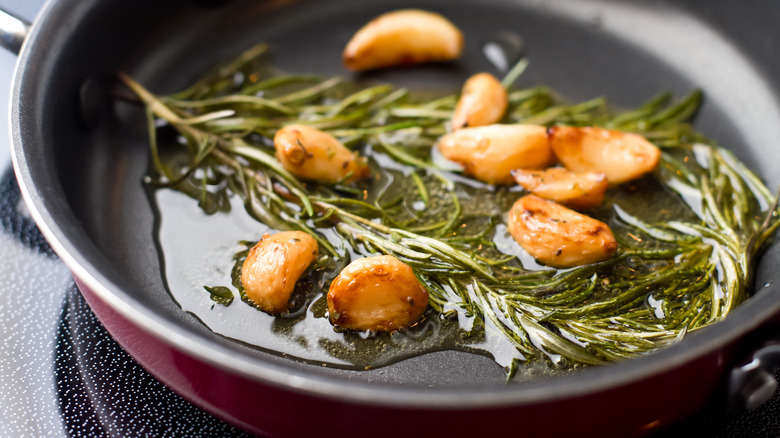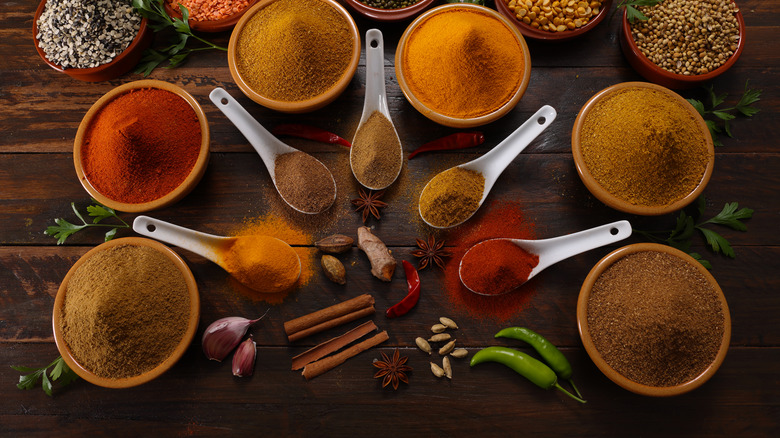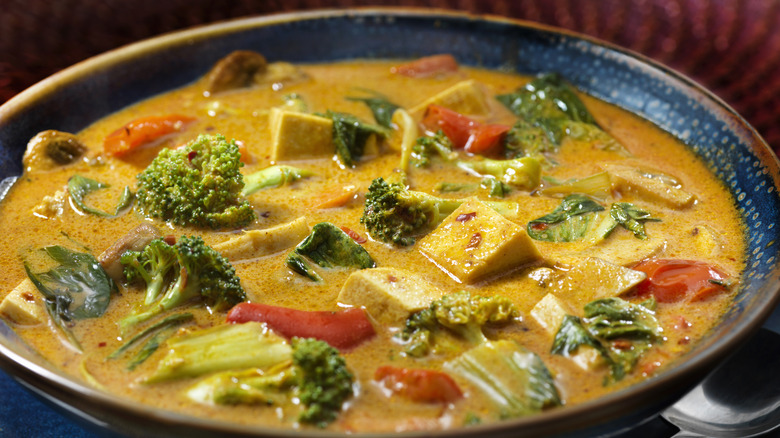The Reason You Should Be Blooming Your Spices
If you want to coax maximum flavor from your spices and seasoning, then it's time to bloom your spices. "Blooming" or tempering is a cooking technique in which seasonings are cooked in oil before they are added to a dish. Heat helps release the aromas and flavors in many herbs and spices. Plus, blooming can add a new dimension to the texture as seeds may be toasted for a tiny touch of crunch.
The technique is deceptively simple. Heat a couple of tablespoons of oil or fat in a pan using medium-high heat. Since blooming is a technique often used in South Asian cuisines, you might try ghee or clarified butter, but other oils with a high smoke point work well too. Add your ground or whole spices to the oil and cook for a minute or two, keeping an eye on your spices to avoid scorching or burning. The challenge is to heat the seasonings and oil long enough to coax out the flavor, but not so long that you run the risk of burning them. You may notice a slightly toasted scent when it is ready to remove from the heat.
Blooming your spices releases more of that delicious scent into the air while also enhancing the taste. It's perfect for those dishes where you want your seasonings to pop with intense flavor or a little toasted crunch.
Blooming releases flavor and scent compounds
Aromatic flowers, herbs, and plant-based spices contain hydrocarbons called terpenes that contribute to scent and taste, according to Finest Labs. In flowers like lavender, the terpenes help attract pollinators like bees, and in other plants like cloves, they repel insects like mosquitos. Terpenes are also in strongly scented plants we use as seasonings, like lemon peel, ginger, and coriander.
While you'll get a milder whiff of the scent and flavor from dried spices and herbs right out of the package, grinding, heating, and especially blooming them release even more of the flavor. Here's how: Terpenes and other scent compounds are fat-soluble (i.e. they break down in fats) and volatile, meaning they evaporate easily and waft into the air. Heating the oil or fat draws out some of those compounds, enhancing the flavor and aroma of your spices. As such, combining spices with heat and oil (fat) releases these scent and flavor compounds into the air.
Some might prefer to toast their herbs and spices in dry heat, but the oil is a key component in enhancing the flavor, scent, and texture of your too. According to Bon Appétit, aromatic ingredients infuse into the oil while cooking, even for a couple of minutes, distributing the flavor throughout. When the oil coats your tongue, you experience both the smooth texture and the enhanced flavor.
Almost any spice can benefit from blooming
Almost any spice or herb can benefit from blooming, especially if they are hardy enough to tolerate a couple of minutes of heat. As blooming is integral to South Asian cooking, any herbs and spices you'd find featured in the cuisine — turmeric, cumin, fenugreek, cinnamon, and ginger — are good candidates, but there are many other options. Garlic, chiles, lemon peel, rosemary, lavender, sage, and thyme are elevated by blooming. For an added crunch, try blooming small seeds like coriander, star anise, cumin, and even cloves. You can also use this technique to invigorate older spices. If you have some dried spices that have been sitting around your pantry awhile and lost some of their potency, blooming can help draw out the remaining scent and flavor.
If you're still unsure which spices are worth blooming, follow in the footsteps of Cook's Illustrated. The publication compared chili flakes bloomed in canola oil with those heated in water. After analyzing both samples in a lab, they found the chili flake oil contained more capsaicin, the compound that gives chili peppers their heat, and estimated that bloomed seasonings may have as much as ten times the flavor. If you are curious whether your favorite seasoning benefits from blooming, we recommend setting up a similar, less scientific version of the test: Take one of your spices, heat some of it in oil and some of it in water, then compare the two. If you prefer the bloomed version, you'll know it's time to add the technique to your toolbelt. Thankfully, it's an easy trick to learn which can be used in a wide variety of applications whether you're reinvigorating stale dried spices or adding intensity to curry or chili.


